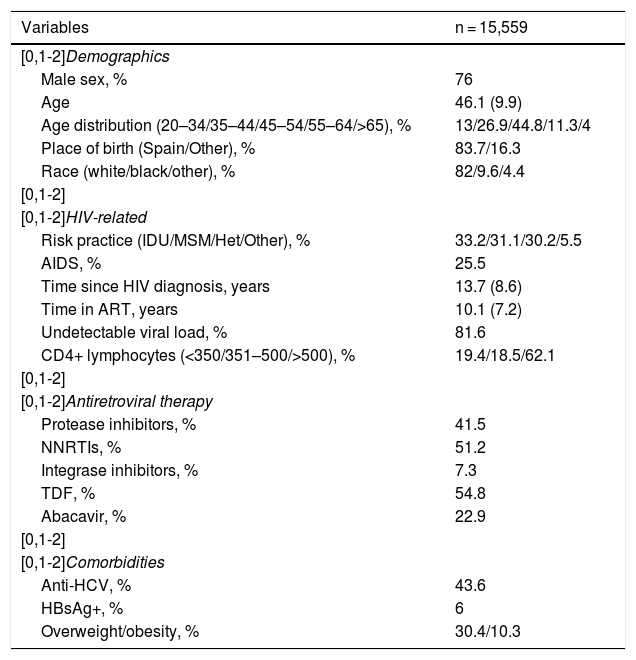The increased survival of patients with HIV infection thanks to antiretroviral therapy (ART) is accompanied by a higher rate of cardiovascular disease (CVD). We analysed the prevalence of the cardiovascular risk factors (CRFs) and estimated the risk of CVD in a cohort of patients with HIV in Spain.
MethodsWe conducted a cross-sectional, observational study of CRFs in the Spanish VACH cohort of patients with HIV who undergo ART.
ResultsThe study assessed 15,559 patients with HIV (76 % men; mean age, 46 years). Some 3.7 % had experienced at least 1 CVD event. The prevalence of CRFs was high (hyperlipidaemia, 64 %; tobacco use, 47 %; arterial hypertension, 22 %; and diabetes, 16 %). According to the Framingham scale, 10.9 % of the patients presented a high CVD risk, and 28.8 % presented a moderate risk. Of the patients with a high CVD risk, 49 % took protease inhibitors and 43 % took abacavir. Fifty-three percent of the patients diagnosed with arterial hypertension took antihypertensive drugs, and 2.6 % of the patients with diabetes took antidiabetic agents.
ConclusionsClassical CRFs are common in patients with HIV undergoing ART in Spain, and a large proportion of them have a moderate-high risk of CVD. Therefore, controlling the modifiable CRFs in patients with HIV should be improved, and the use of drugs with a better cardiovascular risk profile should be assessed.
La mayor supervivencia de los pacientes con infección por VIH gracias al tratamiento antirretroviral (TAR) se acompaña de una mayor frecuencia de enfermedad cardiovascular (ECV). Analizamos la prevalencia de los factores de riesgo (FRCV) y la estimación del riesgo de ECV en una cohorte de personas VIH+ en España.
MétodosEstudio transversal, observacional de los FRCV en la cohorte española VACH de pacientes VIH+ que recibían TAR.
ResultadosSe evaluaron 15.559 pacientes VIH+ (76 % varones, edad media 46 años). Un 3.7 % había sufrido al menos un evento de ECV. La prevalencia de FRCV era elevada: hiperlipemia 64 %, tabaquismo 47 %, HTA 22 % y diabetes 16 %. Según la escala Framingham, un 10.9 % presentaba alto riesgo de ECV y 28.8 % riesgo moderado. De los pacientes con elevado riesgo de ECV, el 49 % recibían inhibidores de proteasa y el 43 % abacavir. Se usaron fármacos hipotensores en el 53 % de los pacientes con diagnóstico de HTA, y fármacos antidiabéticos en el 2.6 % de los pacientes con diabetes.
ConclusionesLos FRCV tradicionales son frecuentes en los pacientes VIH+ con TAR en España y una elevada proporción de ellos tiene riesgo moderado-alto de ECV. Por tanto, el control de los FRCV modificables en los pacientes VIH+ debería mejorarse y valorar el uso de fármacos con mejor perfil de riesgo cardiovascular.
Article
Diríjase desde aquí a la web de la >>>FESEMI<<< e inicie sesión mediante el formulario que se encuentra en la barra superior, pulsando sobre el candado.

Una vez autentificado, en la misma web de FESEMI, en el menú superior, elija la opción deseada.

>>>FESEMI<<<








